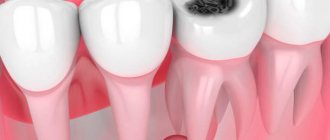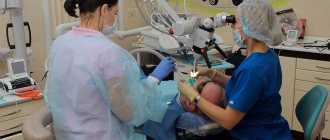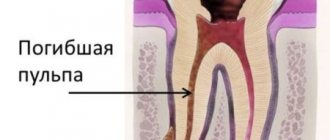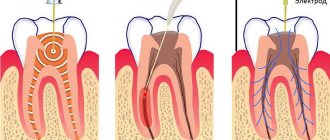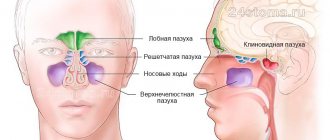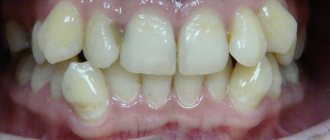Dental therapy is one of the components of dentistry that helps maintain the health and aesthetics of your smile. At the Vimontale aesthetic dentistry clinic, special attention is paid to the treatment of problems such as caries, pulpitis, and periodontitis. We are confident that timely therapy provides better results than the most modern prosthetics. Moreover, without it it is impossible to install modern dentures and orthodontic structures - before using such methods, it is necessary to sanitize the oral cavity and eliminate dental problems.
Therapeutic dentistry
The Vimontale Clinic is a modern center for aesthetic dentistry, equipped with advanced equipment for the diagnosis and treatment of diseases of the teeth, gums and oral cavity. The areas of interest of dental therapists in our clinic include:
- damage to tooth enamel by caries;
- damage to the pulp and periodontium of the tooth as a result of the spread of caries;
- tooth injuries - chips, cracks in the enamel, crown fracture, etc.;
- inflammatory processes in the periodontium, dental pulp and soft tissues of the gums.
Our goal is maximum preservation of teeth in the oral cavity. We do everything possible to avoid their loss. The clinic employs professionals in therapeutic dentistry: experienced doctors and young specialists who master modern and classical technologies for the treatment and restoration of teeth at any stage of destruction. By contacting them, you can be sure that you will receive the necessary assistance.
Some clinical cases of using Metapex
"Metapex" is recommended for temporary filling of root canals. Although it can be used for permanent wear in some cases, it is not considered suitable for this purpose by dental practitioners. However, the composition based on calcium compounds and silicone oils ensures stability while in the root canal - it does not dissolve. Thus, “Metapex” is best used as a means for temporary canal filling if antiseptic treatment of tooth tissue is necessary. The drug is also suitable for sealing in the treatment of various diseases. After positive dynamics appear, it is recommended to replace it with another silar.
Our services
Dentist therapists at the Vimontale clinic treat and prevent the following diseases and defects:
- superficial caries with subsequent strengthening of the enamel;
- deep carious cavities on the front teeth using aesthetic technologies and fillings that are not visible from the outside;
- deep carious cavities on chewing (molar) teeth with the installation of ultra-strong filling materials;
- root canal caries with mechanical and medicinal cleaning, filling with special pastes or gutta-percha pins;
- tooth root cysts with sanitation and enucleation of its cavity to prevent the formation of fistulas;
- fluxes, fistulas and other purulent-inflammatory processes in the tissues of the jaw.
In our work, we use modern equipment and materials that allow us to achieve high quality therapy in a short time. Our arsenal includes ultrasonic, laser and mechanical devices for treating carious cavities, which eliminate pathological tissue in a matter of minutes, completely eliminating re-damage to the tooth. To treat root canals, ultra-modern preparations are used that are absorbed into the tooth and bone tissue and eliminate even hidden foci of infection. The filling materials we use are not subject to temperature influences and maintain aesthetics for at least 5 years.
EXPERIENCE OF USING METAPEX IN THE TREATMENT OF DESTRUCTIVE FORMS OF CHRONIC PERIODONTITIS
The problem of improving the quality of treatment and preventive care for patients with chronic apical periodontitis remains one of the most important in modern dentistry. Improvement of endodontic treatment methods expands the possibilities of conservative treatment of teeth with significant inflammatory processes in the peri-apical tissues. However, according to the literature, after treatment of destructive forms of chronic periodontitis, a fairly high percentage of complications remains [3]. Patients have an extremely negative attitude towards tooth extraction, so endodontic treatment, including repeated treatment, is in demand.
The pathological process in the periapical tissues is usually accompanied by pronounced destructive processes in the bone tissue, which makes it difficult to choose a treatment method. Conservative treatment of periodontal inflammation requires a long period of time. Representing a chronic odontogenic inflammatory focus, periodontitis serves as a source of sensitization of the patient’s body, which leads to significant changes in the immunological status, a decrease in the level of nonspecific resistance, and the development and complication of various somatic diseases [1].
The goal of treatment of periodontitis is the elimination of inflammation in the periapical area, the elimination of the pathogenic effect of the odontogenic inflammatory focus on the body, the regeneration of the periodontal tissue structure and the restoration of tooth function [1].
In endodontics, an important role is played by knowledge of the anatomy of teeth and their root canal system, as well as the correct operation of endodontic instruments and the choice of filling materials. Good knowledge of the topography of the tooth cavity and the architectonics of the root canal system allows one to effectively open the tooth cavity, providing sufficient access to the mouths of the root canals and to their system itself [1, 2]. At the same time, studies in recent years have shown that no more than 70% of the walls of the passable canals are processed qualitatively, mainly at the point of contact with the instrument used [3]. The main part of the microchannels remains practically unprocessed, as well as the narrow, tortuous, non-round macrochannels. The effectiveness of endodontic treatment is largely determined not only by high-quality root canal preparation, but also by rational pharmacotherapy of the root canal and periodontal system.
One of the reasons for failures in the treatment of destructive forms of chronic periodontitis is the inadequate use of drugs for temporary filling of root canals [1, 2].
In the last decade, preparations based on calcium hydroxide have been used to treat periodontitis. To obtain a therapeutic effect, it is enough to create an alkaline environment in the root canal, and direct contact of tissues with calcium hydroxide is not required. For this purpose, a technique is used to temporarily fill root canals with non-hardening pastes based on calcium hydroxide [1]. Due to the alkaline reaction (pH = 12.5), calcium hydroxide has a bactericidal effect, stimulates osteo-, dentin- and cementogenesis. When combined with moisture contained in the channel, the material increases in volume by 2.5 - 3 times, clogging macro- and microchannels and thus ensuring their temporary isolation and disinfection [1].
Also, combination preparations containing calcium hydroxide and iodoform are used to treat destructive forms of periodontitis. These drugs have a pronounced anti-inflammatory effect due to iodoform [1, 2].
This article presents an analysis of the successful use of a drug based on calcium hydroxide and iodoform as a material for temporary obturation of root canals in the treatment of periodontitis with destructive changes in bone tissue in the periapical area.
Under my supervision from 2013 to 2021, at the Republican Center for Medical Prevention, Physical Therapy and Sports Medicine of the Ministry of Health of Chuvashia, there were 38 patients suffering from destructive forms of chronic periodontitis and previously unsanitized root canals, aged from 23 to 46 years. For these patients, I performed endodontic treatment of periodontitis on 42 teeth, of which 15 were multi-rooted and 27 were single-rooted.
In the treatment of chronic periodontitis, Metapex paste (Metapex, Meta Biomed) was used.
Treatment method. After an X-ray examination of the tooth, chemomechanical treatment of the root canal was performed using the Crown Down technique. At each step of changing the size of the endodontic file, the canal was irrigated with a 3% sodium hypochlorite solution. Upon completion of the canal formation, ultrasonic treatment of the root canal was carried out through a 3% sodium hypochlorite solution, 18% EDTA solution, then the root canal was washed with distilled water, dried with a paper pin, the root canal was filled with Metapex paste and canal filler. At the same visit, an x-ray was taken.
After 3 months, a control X-ray examination was carried out. If the paste was absorbed, the canal was refilled. After 6 months from the start of treatment, the Metapex paste was removed, ultrasonic treatment of the root canal was performed through a 3% sodium hypochlorite solution, the canal was washed with distilled water, dried and filled using the lateral condensation method with AN plus sealer (Dentsply). At the same visit, the coronal part of the tooth was restored with a light-curing composite.
The effectiveness of endodontic treatment during X-ray examination was visually assessed on a 5-point scale (Vorobiev Yu.I., Maksimovsky Yu.M., 2001) after 3, 6, 12 and 24 months: 0 points – the destructive process has not been stopped; 1 point – absence of reduction of the periapical destructive process; 2 points – reduction of the periapical process by 1/3; 3 points – reduction of the periapical process from 1/3 to 1/2; 4 points – reduction of the periapical process by more than 1/2; 5 points – complete restoration of bone tissue structure and formation of the cortical plate.
3 months after the start of treatment, the majority of patients (80.6%) showed radiographic changes in the bone condition by 1/3. In 19.4% of patients (8 teeth), further progression of bone tissue destruction in the periapical region was observed. Of these, five are multi-rooted teeth, three are single-rooted. These teeth were re-medicated with disinfectant solutions, and Metapex paste was reintroduced into the canals. After 6 months of observation of these teeth, further progression of the destructive process in the periapical region was recorded on control radiographs in three multi-rooted and two single-rooted teeth (11.9% of patients from the total number of patients observed). Based on these teeth, a decision was made to remove them.
In other cases, after 6 months, positive X-ray dynamics were observed in 88% of cases: in 11.8% of cases - reduction of the destruction site by 1/3, in 76.2% of cases - from 1/3 to 1/2 of the original size.
After 12 months, reduction of the lesion by 1/3 of its original size was preserved in 5.4% of cases (2 multi-rooted teeth), in 13.8% of cases (5 teeth: 4 multi-rooted and 1 single-rooted) - from 1/3 to 1/ 2 from the original sizes, in 80.8% (6 multi-rooted and 24 single-rooted teeth) the reduction was more than 1/2.
After 2 years, 68% of periapical lesions demonstrated complete regeneration (5 points), reduction of the periapical process by more than 1/2 (4 points) was noted in 29.6% of cases, in 2.4% a reduction in the size of the lesion by 1/3 was determined radiographically from its initial size (2 points), which can be regarded as a sluggish course of the pathological process []. A persistent tendency towards reduction of the periapical lesion is detected no earlier than 6 months; the first signs of stable regeneration were detected on an x-ray after a year.
Thus, the treatment of chronic periodontitis using Metapex paste for temporary obturation of root canals is completely justified, however, these forms require complex intervention. This, with positive results achieved in most clinical cases, such as the absence of clinical signs of inflammation and restoration of bone tissue in the periapical area, will determine the significant effectiveness of endocanal therapy.
Bibliography
1. Zhelezny P.A. The effectiveness of drugs with antiseptic and osteostimulating properties in the treatment of complicated caries / P.A. Zhelezny, A.P. Zheleznaya, K.O. Samoilov // Journal of Siberian Medical Sciences. – 2015. – No. 1. – P. 4 – 7.
2. Ivashchenko V.A. Clinical and laboratory evaluation of temporary pastes in the treatment of chronic apical periodontitis / V.A. Ivashchenko, A.A. Adamchik // Kuban Scientific Medical Bulletin. – 2021. – No. 4 (159). – P. 49 – 52.
3. Iordanishvili A.K. Dental health of the nation and ways to preserve it / A.K. Iordanishvili, V.V. Lobeiko, V.V. Samsonov et al. // Periodontology. – 2015. – No. 74 (1). – P. 78–80.
Why you should have your teeth treated at Vimontale
The Moscow aesthetic dentistry clinic Vimontale is one of the few that offers services that combine premium quality and affordability. When you contact us you will receive:
- a detailed free consultation with a dentist with recommendations for oral care and necessary treatment;
- detailed diagnostics using modern X-ray machines and high-precision medical devices;
- high-quality pain relief, which will relieve the slightest discomfort during treatment procedures;
- rapid restoration of the appearance and functionality of teeth.
You can make an appointment for a consultation or dental treatment at Vimontale by calling the number listed in the contacts or using the online form.
Expert of the article you are reading:
Lozinskaya Alla Nikolaevna
Pediatric dentist, general dentist.
You may also be interested in:
Insert teeth Installation of filling Implantation “All on four” Express implantation Metal-free crowns Orthodontist consultation Metal-ceramic crown Children’s orthodontist
Show more
Main advantages of the drug
"Metapex" has a long-lasting bactericidal effect, which is achieved due to pH 12.5. 48 hours after administration of the drug, up to 99% of microorganisms located in the root canal die. The antibacterial component - iodoform - destroys Gram-positive pathogens, staphylococci, streptococci, fungi and viruses. It eliminates the appearance of secondary inflammation even with complications in the form of cysts of various origins. The paste-like consistency ensures convenient administration of the drug without prior mixing. The substance is packaged in a syringe with a sealed cap that protects Metapex from contact with air. The kit includes disposable cannulas for insertion. The substance contains radiopaque components, due to which the sealed canals are visible in the corresponding study. "Metapex" is safe for the soft tissues of the body, so it can be injected into leaky canals and during apexification.
You can purchase Metapex in the catalog of the Stommarket online store (follow the link).
Method and features of use
For permanent and temporary root canal filling, Metapex is applied as follows:
- It is necessary to treat the root canal;
- Then dry it with paper points;
- Insert the tip of the syringe with the drug into the canal;
- Fill the channel;
- Remove excess with a cotton ball.
The cannula tips for the syringe are disposable. The set includes 20 pieces. The cannulas are equipped with a cap for hermetically sealed closure. The drug cannot be stored in an open syringe, since when exposed to air it loses its antimicrobial properties and begins to harden. The drug, like other silars, cannot be taken beyond the apex.
When is tooth canal cleaning performed?
It is necessary to treat and fill root canals in the following cases:
- If caries has progressed to pulpitis (infection has spread to the dental pulp, or colloquially “dental nerve”). The pulp will have to be removed (the tooth depulped), and the root canals in which it was located will have to be thoroughly cleaned of tissue debris and sealed.
- If it is necessary to prepare a dental unit for the installation of a crown and the doctor believes that depulpation is necessary. Previously, when installing single crowns or supporting crowns of a bridge, the teeth were necessarily subject to depulpation; now this procedure is not performed in all situations and only when installing certain types of dentures.
- If there is a need for re-treatment of the tooth after the occurrence of a secondary source of infection or with the development of periodontitis, inflammation of the tissues around the tooth root (develops with poor-quality canal filling).
In all these situations, endodontic treatment is carried out (the name comes from the Latin words “inside” and “tooth”, that is, it can be literally translated as intradental treatment) with mandatory filling of the dental canals.
If you have a problem similar to that described in this article, be sure to contact our specialists. Don't diagnose yourself!
Why you should call us now:
- We will answer all your questions in 3 minutes
- Free consultation
- The average work experience of doctors is 12 years
- Convenient location of clinics
Single contact phone number: +7
Make an appointment
Treatment of periodontitis in one visit
Over the past decades, methods for treating chronic periodontitis have been improved, which has reduced the number of visits to one.
The indication for treatment of periodontitis in one visit is the presence of a fistulous tract in a single-rooted tooth. An outflow of purulent discharge occurs through the fistula, so filling the canal and removing the filling material beyond the apical opening of the tooth root is not accompanied by an exacerbation of the inflammatory process.
If conservative treatment of chronic periodontitis is ineffective, surgical methods are resorted to, in particular cystectomy and root apex resection.

